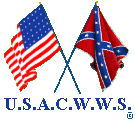
|
U. S. CIVIL WAR
PHOTOGRAPHS
|

|
MURFREESBORO
(STONES RIVER)
PAGE 3 OF 6 PAGES
| |

Cotton Field - "No Man's Land" (F)
Rail fences like this one kept free ranging livestock out of farm fields.
These fences were quickly consumed by both armies for firewood and
breastworks . Courageous Confederate infantry made several charges across
the field from noon on the 31st until dusk. Union cannon posted to your
right, and on the rise across Nashville Pike, made this crossing almost
suicidal. . Courageous Confederate infantry made several charges across
the field from noon on the 31st until dusk. Union cannon posted to your
right, and on the rise across Nashville Pike, made this crossing almost
suicidal.
From that afternoon, through the evening of January 3, 1863, this cotton
field was a no man's land occupied by the dead and wounded of both sides.
Sharpshooters and skirmishers exchanged shots during the period making it
dangerous to expose oneself. Federal artillery frequently shelled the woods
seeking to harass the Confederates who occupied the crude breastworks
behind you. On January 5, 1863, the grim work of burying the dead began.
|
Some of the hardest fighting took place in the area known as Round Forest, near
the present day Hazen Monument, and at the junction of McFadden's (now Van Cleve)
lane and the Nashville Pike. At times the noise was so loud that soldiers stuffed
their ears with cotton.

Chicago Board of Trade Battery (E)
|
Panic-stricken Union troops bolted out of the woods, closely pressed by
cheering Texans. Canister from the battery's six guns, placed on this rise,
forced back the attackers. Reinforced by a second battery, the Union
artillerymen repulsed a second assault to save the Pike, their lifeline to
Nashville, from capture.
|

Parsons's Battery (G)
4th U.S. Artillery Co. "H" & "M"
|
The most powerful federal battery on this field armed with four 3" Ordance
rifles and four 12 pdr. howitzers. This battery of battle hardened regulars
poured charge after charge of canister at less than 600 yards into the
oncoming grey ranks - helping stifle attacks on the Round Forest and the
Nashville Pike, on the morning and early afternoon of December 31, 1862.
At times the Confederate Infantry were on three sides of the battery, but
Lt. Charles C. Parsons gave no ground. During the entire battle, Parsons
fired more than any battery, 2,299 rounds, and suffered very few
casualities, due chiefly to the havoc caused by their deadly accurate fire.
Parsons was promoted to the rank of captain for his herioc action at
Stones River.
|

Cotton Field near Parsons's Battery - 2002 (G)

Hazen's Artillery (C)
This section of guns represent Battery F, 1st Ohio Volunteer Artillery
commanded by Lt. Norrel Osburn (four James Rifles & two 12 pdr. howitzers).
Along with Capt. Jerome B. Cox's 10th Indiana Battery (four 10 pdr.
Parrotts and two
12 pdr. howitzers) located across the railroad tracks to the north, this
battery was able to hold its ground, helping Col. Hazen maintain his
position during the crucial afternoon of December 31, 1862. The excellence
of Union artillery saved the day for the Union army, by protecting the
vital supply line on the Nashville Pike. and two
12 pdr. howitzers) located across the railroad tracks to the north, this
battery was able to hold its ground, helping Col. Hazen maintain his
position during the crucial afternoon of December 31, 1862. The excellence
of Union artillery saved the day for the Union army, by protecting the
vital supply line on the Nashville Pike.
|
|
|
PAGE FOUR
 >
Civil War Photos
>
Western Map
>
Murfreesboro
>
Page 2
>
3
>
4
>
5
>
6
>
Civil War Photos
>
Western Map
>
Murfreesboro
>
Page 2
>
3
>
4
>
5
>
6
|
|



